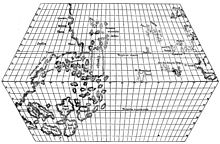Paolo dal Pozzo Toscanelli

Paolo dal Pozzo Toscanelli (1397 – 10 May 1482) was an Italian
Life
Paolo dal Pozzo Toscanelli was born in Florence, the son of the physician Domenico Toscanelli and Biagia Mei.[1] There is no precise information on his education and background. Gustavo Uzielli claimed in 1894 that Toscanelli studied at the University of Padua, but modern authors consider this pure conjecture.[2] Toscanelli lived most of his life in Florence, with occasional excursions to Todi and Rome. He is said to have entered into correspondence with scholars around Europe, but his writings have yet to be thoroughly researched.
Thanks to his long life, his intelligence and his wide interests, Toscanelli was one of the central figures in the intellectual and cultural history of
Toscanelli along with Nicholas of Cusa appears to have belonged to a network of Florentine and Roman intellectuals who searched for and studied Greek mathematical works, along with
Cartography


In 1439, the Greek philosopher
In 1474, Toscanelli sent a letter and a map to his
An uncorroborated story links Toscanelli’s attendance at a Chinese delegation to the Pope in 1432, when many Chinese inventions were discussed, with a flood of drawings made around the same year by the artist-engineer
Also in the time of
Eugenius one of them [of Cathay] came to Eugenius, who affirmed their great kindness towards Christians, and I had a long conversation with him on many subjects, about the magnitude of their rivers in length and breath, and on the multitude of cities on the banks of rivers. He said that on one river there were near 200 cities with marble bridges great in length and breadth, and everywhere adorned with columns. This country is worth seeking by the Latins, not only because great wealth may be obtained from it, gold and silver, all sorts of gems, and spices, which never reach us; but also on account of its learned men, philosophers, and expert astrologers, and by what skill and art so powerful and magnificent a province is governed, as well as how their wars are conducted.
It has been suggested that the man in question may have been
In a second letter, Toscanelli describes further these men as extremely learned and willing to share their knowledge:
The said voyage is not only possible, but it is true, and certain to be honourable and to yield incalculable profit, and very great fame among all Christians. But you cannot know this perfectly save through experience and practice, as I have had in the form of the most copious and good and true information from distinguished men of great learning who have come from the said parts, here in the court of Rome, and from others being merchants who have had business for a long time in those parts, men of high authority.
— Extract of the First Letter of Paolo Toscanelli to Columbus[9]
Astronomy

Toscanelli is noted for his observations of six comets,[1][10] in 1472, two in 1457, 1456, which was to be named Halley's Comet after Edmond Halley predicted its return in 1759, 1449, and 1433.[11]
In 1475 he pierced a hole in the dome of Florence Cathedral making a gnomon[12][13][14] at 91.05 metres (298.7 ft) above the pavement to create a meridian line.[15] The height precluded the installation of a complete meridian line of the floor of the cathedral, but allowed a short section of approximately 10 metres (33 ft) to run between the main altar and the north wall of the transept. This allows for observation for around 35 days either side of the summer equinox.
See also
- The Pinzon Brothers
- Juan de la Cosa
References
Citations
- ^ ISBN 978-0-387-31022-0. Retrieved 17 March 2023.
- ISBN 978-0226907338., pp. 333–335
- ^ "Paolo Toscanelli". The Linda Hall Library. Retrieved 15 August 2022.
- ^ a b "Point of View" Day the Universe Changed
- ^ Phillips, William D.; Phillips, Carla Rahn (16 March 1992). "The Worlds of Christopher Columbus". Cambridge University Press – via Google Books.
- ^ Markam, p.7 Full text of the letter
- ^ Davidson, p.52 Another translation
- ^ "Columbus then and now". University of Oklahoma Press. 16 March 1997 – via Internet Archive.
- ^ Markam, p.10 Full text of the letter
- ^ "The beginning of a scientific approach | Comets". cometes.obspm.fr. Retrieved 17 March 2023.
- ^ Manca, Francesco; Sicoli, Piero. "Ancient Comets in Italy". www.brera.mi.astro.it. OAS - Osservatorio Astronomico Sormano. Retrieved 17 March 2023.
- doi:10.1038/073258a0– via www.nature.com.
- ^ "The Line of the Sun". brunelleschi.imss.fi.it.
- ^ "The gnomon of the Cathedral of Santa Maria del Fiore". duomo.firenze.it.
- ISBN 0674005368.
Bibliography
- Armando Cortesão, Cartografia Portuguesa Antiga, Lisboa, 1960.
- Armando Costesão, História da Cartografia Portuguesa, 2 vols., Lisboa, 1969–1970.
- Davidson, Miles H. Columbus then and now: a life reexamined University of Oklahoma Press, 1997 ISBN 0-8061-2934-4
- G. Uzielli, La Vita e i tempi di Paolo di Pozo Toscanelli, Roma 1894.
- Quinn, David B. Quinn The European Outthrust and Encounter: The First Phase c. 1400–c. 1700 Liverpool University Press, 1994 ISBN 0-85323-229-6
- Markam, Clements R. Journal of Christopher Columbus (During His First Voyage, 1492–93) and Documents Relating to the Voyages of John Cabot and Gaspar Corte Real Ayer Publishing, 1972 ISBN 0-8337-2230-1
- Rahn Phillips, Carla The Worlds of Christopher Columbus Cambridge University Press, 1993 ISBN 0-521-44652-X
- Kern, Ralf. Wissenschaftliche Instrumente in ihrer Zeit. Vom 15. – 19. Jahrhundert. Cologne: Koenig, 2010. ISBN 978-3-86560-772-0.
External links
 This article incorporates text from a publication now in the public domain: Herbermann, Charles, ed. (1913). "Paolo dal Pozzo Toscanelli". Catholic Encyclopedia. New York: Robert Appleton Company.
This article incorporates text from a publication now in the public domain: Herbermann, Charles, ed. (1913). "Paolo dal Pozzo Toscanelli". Catholic Encyclopedia. New York: Robert Appleton Company.- Paolo dal Pozzo Toscanelli at the Mathematics Genealogy Project
- Mahn-Lot, Marianne (1986). "DAL POZZO TOSCANELLI, Paolo". ISBN 978-8-81200032-6.
